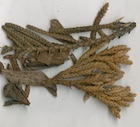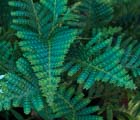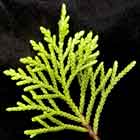
A portion of the isotype of L. chevalieri, collected 1947.12.28 by J.T. Buchholz, showing fertile twigs bearing female cones. Note the bract-scale complexes (the seed cones) and the spiny free tips of the scales. The size of the cones and length of the spines are important characters in identificaton of Libocedrus species, as are the morphology of the facial and lateral leaves.

Foliage of Libocedrus austrocaledonica [C.J. Earle, 2015.02.25].

Foliage of Libocedrus bidwillii [C.J. Earle, 2003.03.09].

Foliage of Libocedrus chevalieri [C.J. Earle, 2015.02.25].

Foliage of Libocedrus plumosa [C.J. Earle, 2003.03.01].

Foliage and mature seed cones on Libocedrus uvifera [Jeff Bisbee, 2013.02].

Foliage of Libocedrus yateensis [C.J. Earle, 2015.02.25].

Libocedrus
Endlicher 1847
Common names
Taxonomic notes
Libocedrus was once a catchall genus for a variety of somewhat eccentric, predominantly austral members of the Cupressaceae. As study proceeded, it became clear that many of these species warranted distinct, often monotypic genera. Consequently former members of the genus are now found in Austrocedrus, Calocedrus, and Papuacedrus. Molecular studies (Gadek et al. 2000, Leslie et al. 2012) have now shown that Libocedrus is sister to a clade containing the Gondwanan genera Callitris, Diselma, Fitzroya, and Widdringtonia; joins them in a clade sister to Austrocedrus; and joins it in a clade sister to Papuacedrus. The analysis by Leslie et al. (2012) considered five of the six species and found close relationships between the New Caledonian species L. austrocaledonica and L. yateensis; it seems reasonable to expect that the third New Caledonian species, L. chevalieri, would also fall within the clade. These species were sister to a clade containing L. uvifera (South America) and L. bidwillii (New Zealand), and these species all sister to L. plumosa. The genus now has six generally-accepted species:
Description
Monoecious or, rarely, dioecious evergreen trees or shrubs. Bark thin, shed in long strips. Branchlets distichously divided and flattened into fern-like sprays. Winter buds hidden by leaves. Leaves scale-like, flattened, decussate, the facial pairs short-decurrent; on older branchlets becoming larger and more spreading. Juvenile leaves longer and more spreading. Male and female strobili solitary, terminal, usually on different branches of the same tree. Male strobili oblong, with 6 - 12 decussately arranged, peltate, sporophylls. Female strobili ovoid, with 4 decussate, erect, woody, persistent scales, the outer smaller and sterile. Mature cones woody, ripening the first year, the scales valvate, each with a spine-like or triangular appendage on the back, each fertile scale bearing 1 or 2 flattened seeds which are very unequally winged, the lower wing erect and broad, the other narrow or rudimentary (Dallimore et al. 1967).
The New Zealand species are keyed as follows (Allan 1961):
| Branchlets flattened; cones 15 cm. long or more; dorso-ventral and lateral lvs unequal |
L. plumosa |
| Branchlets tetragonous; cones not more than 1 cm. long; dorso-ventral and lateral lvs about equal |
L. bidwillii |
Distribution and Ecology
New Zealand (2 endemic spp.), New Caledonia (2 endemic spp.), Chile and Argentina (1 endemic sp.).
Remarkable Specimens
Libocedrus uvifera may have formerly reached diameters of 300 cm and surviving specimens attain 150 cm; trees of that size may also exist among L. bidwillii and L. plumosa, but I can find no records of them. The tallest is L. plumosa, with specimens recorded up to 31 m tall. That is probably a rough approximation, as it is for a New Zealand species and is close to 100 feet, which is a very round number; but none of the other species are recorded as exceeding 20 m in height.
There are no age data for most species, but L. uvifera has been recorded to 880 years, with L. bidwillii running to 720 years.
Ethnobotany
"Wood reddish-brown or brown, fragrant with a spicy resinous odour, durable, easily worked, finishing with a good surface. Suitable for building purposes where great strength is unnecessary, the indoor finish of houses, and other work. No species of Libocedrus is sufficiently common to be of much importance as a source of timber" (Dallimore et al. 1967).
Observations
Remarks
Named for the Greek libas, drop or tear, and cedrus, from its resinous character (Dallimore et al. 1967).
Plants of this genus have been found in early Miocene (about 20 million years ago) sediments in southern New Zealand (Pole 2007).
Citations
Allan, H. H. 1961. Flora of New Zealand. Volume I, Indigenous Tracheophyta. Wellington: R.E. Owen Government Printer.
See also
Farjon (2005) provides a detailed account, with illustrations.






